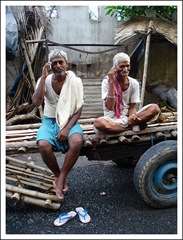The sudden rush for the rural pie
If you are noticing India Inc’s moves of late then you are bound to notice a trend. Most of the companies are rushing for the rural areas. Be it telecom, banking, computing or the auto industry. What prompts the companies to look for rural frontiers?
For one reason, the rural market is largely untapped and provides a huge growth potential. For sectors like telecom most  of the urban areas are saturated with a tele-density of greater than 70%. Rural areas are the obvious choice to expand. The most important reason of all is 70% of India’s population lives in rural areas.
of the urban areas are saturated with a tele-density of greater than 70%. Rural areas are the obvious choice to expand. The most important reason of all is 70% of India’s population lives in rural areas.
After C.K. Prahalad’s book about Fortune at the bottom of the pyramid no one really took notice of the rural markets except for the case studies mentioned in the book.
Now, what we are seeing is a sudden rush for the rural market. Not only are the companies rushing for the rural markets but are designing products that would be apt for the market. Be it the new set-top boxes for DTH penetration or the set-top boxes to access Internet and TV, the products are designed for rural markets. Which makes it abundantly clear that what works in urban market does not work in rural market.
If we take the example of telecom industry, the regular laying of the network and selling phones and pre-paid cards alone will not work. Towers need electricity and most of the rural areas are short of it. They have to run the towers on diesel and generators. This operational cost is the major chunk for any telecom company.
That could be the reason why telecom companies were reluctant to penetrate rural markets at the same pace as they did for urban markets. The regular towers which run on electricity might not be the solution. There are efforts to make solar GSM towers which run on the sunlight and wind power as I have blogged here. There are also companies like Ericsson which are working on a similar kind of tower which consumes less of the fossil fuel.
Financial inclusion is another area which needs improvement and provides opportunity.
By 2012, State Bank of India hopes to reach out to 100,000 villages that don’t have any banking facilities (Mint)
SBI is taking the help of biometrics to bridge the financial inclusion divide. It uses a biometric machine which costs less than 25000 rupees to bring in the people in rural areas to become bank account holders. This is part of the National Rural employment Guarantee scheme.
The money of which is deposited into the bank accounts and the people can transact with a banker who visits them. Though the SBI initiative is not profitable, if it achieves its targets then it will all make sense.
Tata Nano is another example. Though it is dubbed as a city car, it finds most of its usage in rural areas. If Tata approves the request for a yellow card to make it a taxi then most of the urban users will shy away which makes it ideal for rural market.
There are many examples like the DTH and DishTV penetration, the rural telephony initiatives, the low-cost computing initiatives and rural BPO’s which are tapping the fortune at the bottom of the pyramid.
Most of them might have just scratched the surface but many of them have realized the potential for sure.
*Image credit

Other big push areas are insurance and the financial sector. Think about what will happen if the unaccounted money is slowly but surely pushed into the main economy.
anand